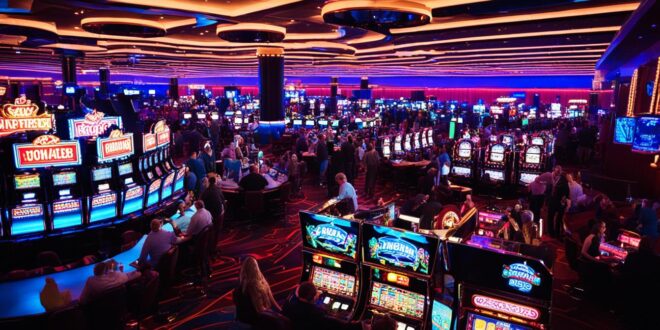Delving into the intricacies of casino design reveals the careful consideration of psychological elements that drive player engagement and profitability. On the bustling floors of today’s gaming temples, every architectural nuance and aesthetic detail is a testimony to the layout strategies in casinos, carefully crafted to create an environment that captures the senses. From the carpet patterns underfoot to the grand chandeliers that light up the baccarat tables, every element is methodically designed to offer an immersive experience that guests find irresistibly engaging.
Casino design psychology isn’t just about the glamour and dazzle; it’s a scientific approach to driving player engagement, using auditory, visual, and lighting features to foster a space where time slips away and pleasure takes the main stage. These establishments are not merely places of chance; they are temples of temptation, where every corner, pathway, and alcove is an invitation to play more, stay longer, and indulge in the thrilling pursuit of fortune.
Understanding the Goals of Casino Design

The sophisticated world of casino design is much more than a spectacle of lights and sounds—it’s an intricate dance of psychology and strategy. Casinos are not just venues for entertainment; they are carefully crafted spaces that aim to guide visitor behavior and enhance the gaming experience. The architecture and the layout are deliberately structured to influence guest interactions with games, leading to increased stay duration and likelihood of gambling, thereby bolstering the casino’s bottom line.
The Dual Mandate: Profit and Player Enjoyment
Casino layout strategies have evolved to fulfill a dual mandate: to create a space that is both profitable for operators and enjoyable for patrons. Central to these strategies is the understanding that a player’s environment can significantly affect their gaming decisions. The casino ambiance is meticulously curated to invoke sensations of excitement and comfort, which in turn impacts gambling behaviors. By using psychological principles, designers curate environments that balance the psychological effects of casino ambiance with the thrill of the game.
Aligning Architecture with Business Objectives
To align architecture with business goals, casinos resort to a blend of design elements that subtly nudge players into prolonged play. How casinos guide player behavior goes beyond mere aesthetics; it is a strategic emulation of moods, achieved through lighting, sounds, and the strategic placement of gaming tables and slot machines. All these elements work together to envelop players in an atmosphere that both disarms and enchants, pushing the cognitive boundaries that usually dictate spending habits and risk evaluation.
Casino designers carefully craft floor plans to lead patrons on a journey through the establishment, making each step enticing and drawing them deeper into the gaming experience. It’s a delicate balance of freedom and guidance that aims to make the casino space equally welcoming and conducive to gambling activities. The end goal is a harmonious environment where pleasure and business prospects seamlessly converge, maintaining an elevating trajectory for the casino’s profitability.
Traditional Versus Playground Casino Design
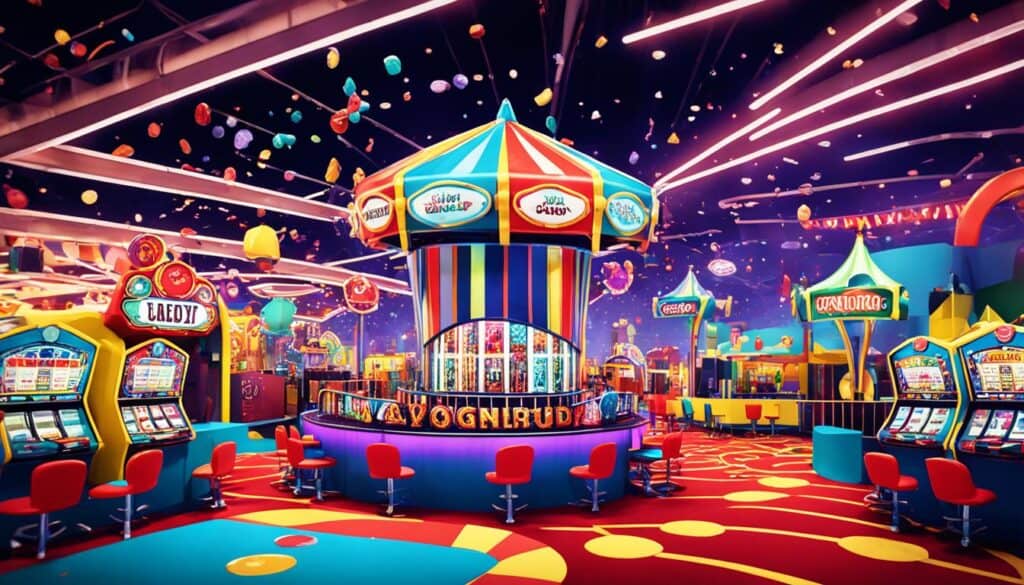
The evolution of casino interiors from the traditional casino design to the more contemporary playground casino design represents a significant shift in the philosophy of casino architecture. The traditional casino design, often referred to as Friedman-esque design, was characterized by its maze-like layouts that aimed to captivate the player’s attention solely on gambling, obscuring exits, and minimizing any perception of time passing. To understand this transformation, it is vital to examine the defining elements of both approaches.
- Friedman-esque Design:
- Enclosed gaming areas to maintain focus on gambling activities
- Low ceilings and dimmer lighting to create a gambling den atmosphere
- Strategically placed amenities to ensure gaming equipment is the central attraction
- Playground Casino Design:
- Spaces are expansive, luxurious, and filled with natural light
- Designs include art and high-end decor that provide an aesthetic appeal beyond gaming
- The inclusion of windows and clocks, allowing patrons to stay aware of external environment and time
Inspired by the revolutionary ideas of designer Roger Thomas, the playground casino design emerged as a juxtaposition to the traditional form. Establishments such as the Bellagio, where Thomas’ concepts have been implemented, showcase how this style not only elevates the player’s experience but also contributes to elevated profits. By offering a comfortable and aesthetically pleasing environment, these casinos have proven that luring players into a more inviting space can encourage longer stays and increased spending.
This transformation underlines an important trend in casino design where the satisfaction of the guest is as paramount as the profitability of the venue. The effect of this shift on both player engagement and the bottom line has led many to reevaluate the physical spaces of gambling and entertainment.
Navigational Tactics in Casino Layouts
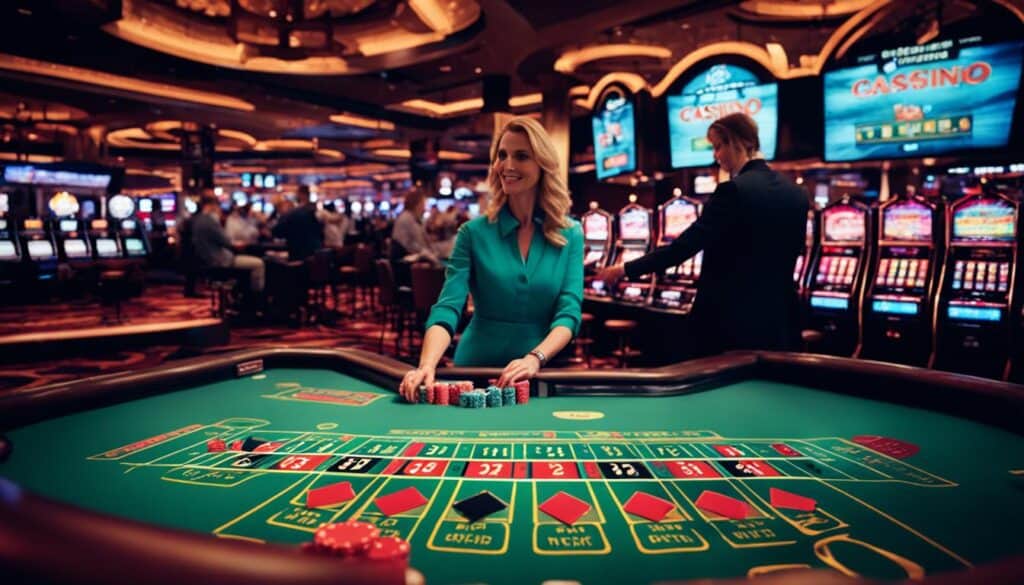
The intricate design elements in casinos are more than just about aesthetics. They play a pivotal role in the psychological engagement of patrons, with navigational tactics being a key ingredient in the casino layout’s secret recipe. High-stakes environments are meticulously crafted using various architectural and design strategies to create a dynamic space that subtly guides and influences the behavior of visitors. Understanding the underpinnings of these navigational tactics can offer valuable insights into the sophisticated world of casino layouts.
The Impact of Pathways and Game Placement
When walking through the sprawling floor of a casino, one may not immediately recognize the deliberate path laid out before them. Pathways are engineered to lead guests past an array of games, evoking curiosity and tapping into emotional triggers in the casino environment. A strategically meandering path ensures that no game goes unnoticed and the opportunity to play is always within arm’s reach. The layout acts much like a story, with each section revealing a different chapter designed to captivate the player’s interest.
- Meandering Walkways: These pathways are designed to increase exposure to different games, tempting visitors as they navigate through the space.
- Strategic Game Clusters: Groupings of popular games act as anchor points along the journey, encouraging players to stop and take part.
- Visibility of High-Traffic Areas: Ensuring visibility of high-stakes or high-energy areas creates a magnetic draw, enticing guests to venture closer.
Design Intentionality in Directing Player Movement
In the realm of casino design, nothing is left to chance. Each element is purposefully placed to guide movement and encourage engagement. From the welcoming entrance to the constellation of games, the casino floor is an orchestrated environment where every component works in harmony to influence behavior. Designers often leverage emotional triggers, such as excitement and curiosity, to keep patrons circulating and exploring. Navigational tactics are therefore a cornerstone of the intentional design in casino layouts.
- Entrance Placement: The positioning of the entrance can be pivotal, setting the tone and direction for the patron’s entire visit.
- Avoiding Grid Layouts: Non-linear pathways prevent quick exits and foster a sense of discovery.
- Encounter Points: Placement of bars, lounges, and services encourage players to take a break while still being surrounded by gaming activity.
These navigation and design elements coalesce to create an alluring and addictive atmosphere that keeps guests coming back for more. The layout is a silent salesman, enticing people to stay longer, play more, and ultimately, contribute to the thriving pulse of the casino.
Casino Color Schemes and Player Engagement
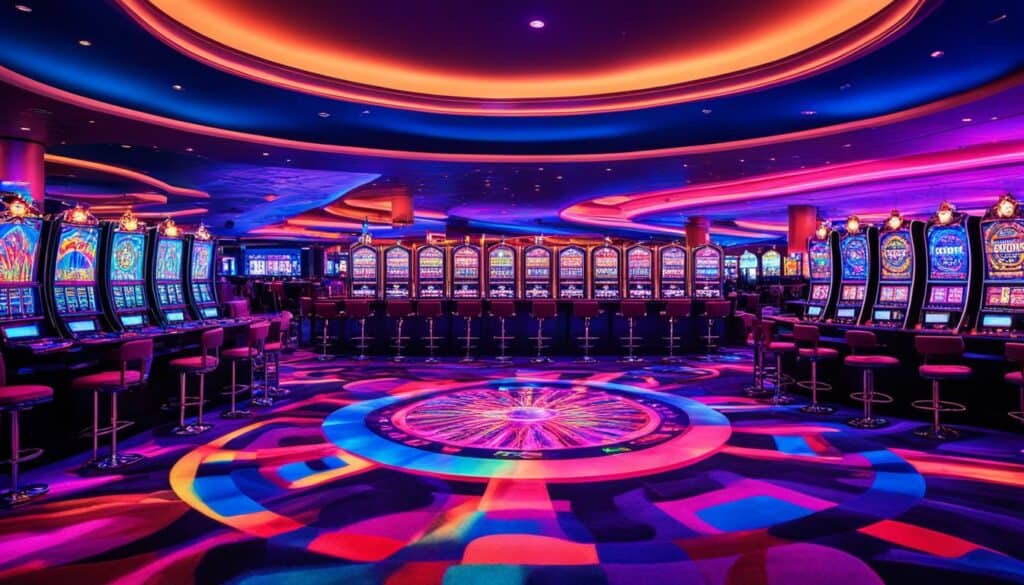
The strategic use of color in casino environments serves as a key player in driving player engagement and eliciting various emotional responses in casino settings. Operators and designers tap into the psychological power of colors to create a space that not only stands out aesthetically but also influences gamblers’ behavior and perception.
Studies have shown that different casino color schemes can have distinct impacts on the mind, where each color holds the potential to evoke specific emotions and actions among patrons:
- Red and orange tones are often associated with excitement and increased heart rate, prompting more energetic betting activity.
- Blue and green hues, known for their calming effect, are selected to encourage longer stays and a relaxed atmosphere.
- Black and gold represent sophistication and luxury, tempting players into higher stakes with the promise of glamorous rewards.
Yet, it’s not only about individual colors but also about how they blend to create an immersive experience. A cohesive color scheme aligns with the theme of the casino, whether it’s the vibrancy of a Las Vegas strip or the elegance of an exclusive high-roller lounge, each designed meticulously to enhance psychological comfort and, consequently, customer spending.
Cultural significance also plays a crucial role, as colors carry different meanings around the world. Understanding these nuances enables casinos to cater to diverse demographics, ensuring an appealing environment for all players.
In essence, the application of color in casinos is a delicate art that, when executed strategically, serves as a silent yet persuasive salesman, subtly guiding patrons through a psychological journey that encourages both engagement and enjoyment.
How Casinos Guide Player Behavior with Design Elements
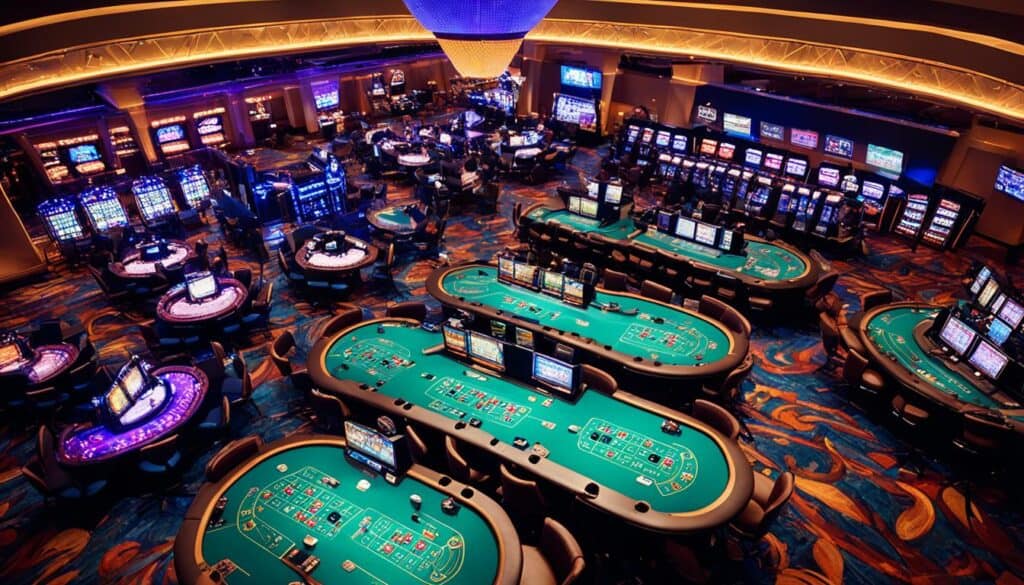
The carefully crafted architecture of casinos is not merely for aesthetic pleasure; it plays a critical role in influencing gambling behavior. By understanding the tactical employment of space and how it is perceived by players, casinos create environments that subtly persuade patrons to stay longer and engage more with their offerings. This section sheds light on the distinguished methods by which casinos leverage these design elements to modify player behavior.
Strategic Use of Space and Ambience
When entering a casino, the expanse of the gaming floor and the overall ambience can immediately impact a gambler’s psychological state. Leveraging the gambling behavior influenced by casino architecture, the design aims to both awe and provide comfort. Luxurious decor combined with a spacious layout reduces the feeling of crowding, crafts a sense of exclusivity, and encourages exploration which neatly extends the duration of play.
- Minimization of windows and clocks to diminish the awareness of time
- Strategic game placement to create a journey through different types of games
- Clustered arrangements for slot machines to create dynamic energy pockets
Audiovisual Cues and Influence on Gamblers
The important role of audiovisual cues in casinos aids in fine-tuning the emotional and psychological disposition of the gamblers. Integrated player behavior modification strategies use controlled lighting and sound to establish an atmosphere conducive to gambling. These cues are well-thought-out stimulants, designed to work on a subconscious level, to entice players towards gaming activities.
- Soft background sounds to reduce stress and promote a relaxed state
- Uplifting melodies to boost confidence and the likelihood of placing a bet
- Flashing lights and triumphant sounds from slot machines signaling wins and encouraging nearby players
The Influence of Luxurious Aesthetics on Gambling Habits
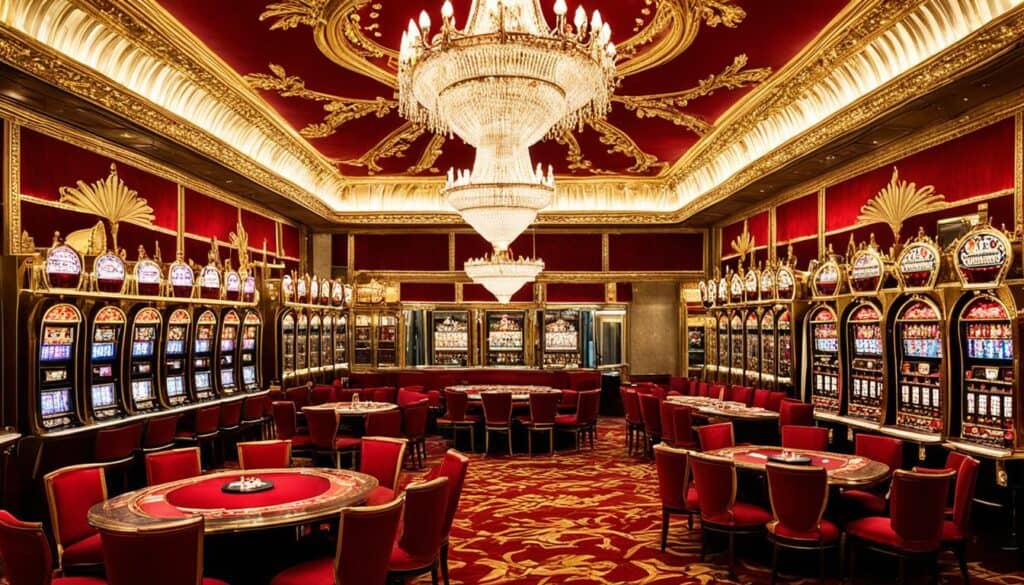
It’s well-documented that luxurious casino aesthetics directly impact the psychology of gamblers, creating an enthralling atmosphere that can influence gambling habits. The plush interiors of a casino serve not just as a backdrop but as a character in the play of gambling, with the power to entice and retain guests. An environment that exudes opulence and comfort fosters a psychological space where players feel more inclined to take risks, alluding to the belief that the setting reflects the potential rewards.
Enticing casino environments are the cornerstone of a memorable gambling experience. Each detail, from the lush carpeting underfoot to the sparkling chandeliers overhead, is meticulously orchestrated to build an ambiance of exclusivity and prestige. Such environments prompt guests to match the perceived high standards, often resulting in more liberal spending and prolonged gaming sessions. Here’s how luxury influences a player’s approach to gambling:
- Lavish decor reduces psychological barriers to spending, implicitly suggesting that money is no object in pursuit of the ultimate experience.
- Opulent fixtures, such as high-end furniture and art, create a sense of being treated to a unique and prestigious experience, raising stakes and expectations.
- The inclusive atmosphere of luxurious spaces appeals to the desire for social affirmation, leading to communal betting or higher individual wagers in hopes of gaining recognition from peers.
This magnified reality within casinos doesn’t just seduce; it charms players into a dance of chance where the rhythm is set by glittering lights and sumptuous textures. The very essence of gambling is transformed in settings designed to whisper promises of potential wealth and grandeur, dictating not only how long one plays but also the audacity of their bets.
Casino Design Psychology in Modern Gaming Venues
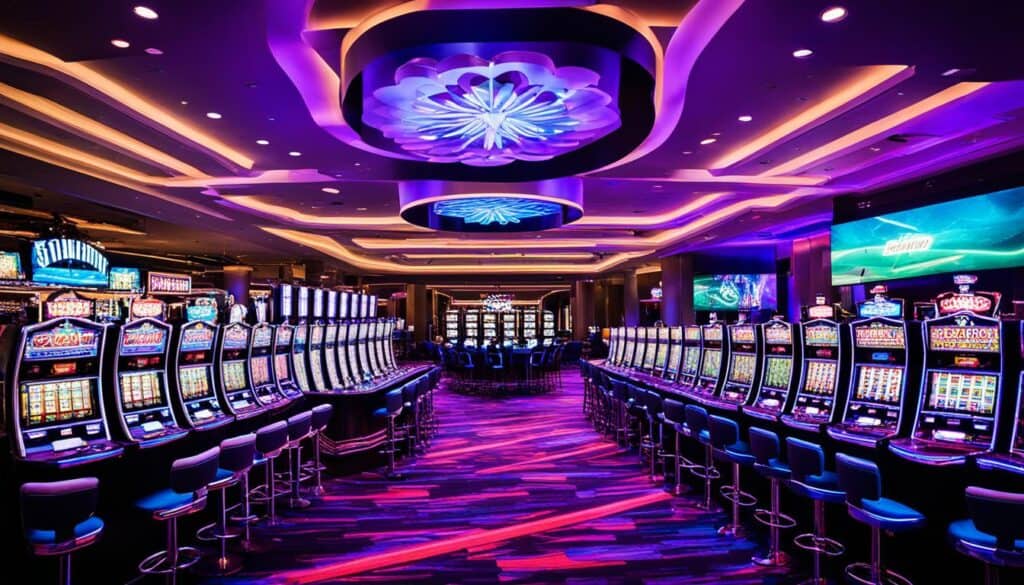
The advent of modern casino venues has brought with it an array of sophisticated design tactics aimed squarely at influencing betting behavior. Infused with principles of design psychology, these environments are meticulously crafted to combine aesthetics, comfort, and sensory engagement, cultivating an atmosphere that not only enchants guests but markedly shapes their gambling habits.
Underpinning this strategic manipulation of space and style is a keen understanding of the psychological forces at play within the casino floor. Designers tap into emotional triggers and subconscious motivators, focusing on elements that pique interest and naturally guide players towards the gaming tables or machines.
- Analysis of player pathways, ensuring the journey through the casino is both engaging and likely to encourage betting.
- Use of luxury visual cues that subliminally signal wealth and success, persuading players to chase the high-end casino experience through gambling.
- Integration of comfort with style, creating an environment in which players are inclined to relax and stay longer, invariably increasing the likelihood of gambling.
These strategies collectively serve to refine the guest experience while discreetly nudging behavior towards increased engagement with gambling activities. Through the thoughtful employment of design elements, modern casino venues optimally leverage the influence on betting behavior, achieving the dual goals of enhanced player satisfaction and maximized profitability.
The Role of Lighting in Creating Casino Ambiance
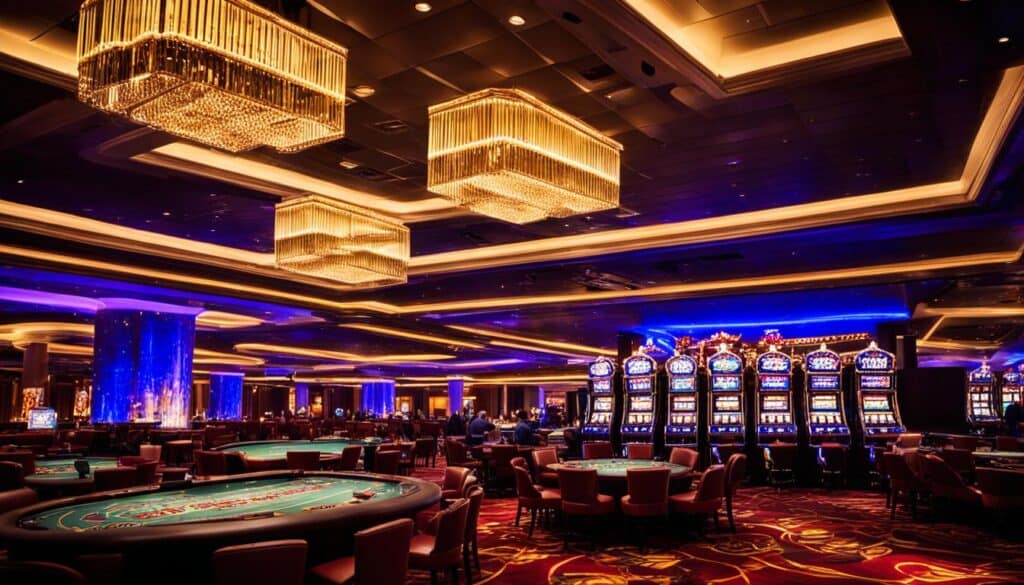
With the slightest adjustment in illumination, a casino can orchestrate a symphony of emotions among its patrons. The strategic application of lighting effects on gamblers not only alters their visual perception but also plays a masterful role in invoking a spectrum of emotional triggers. This intricate dance between light and psyche is the cornerstone of a magnetic casino ambiance, one that casts a glow on the endless possibilities hidden within the roll of a dice, the spin of a wheel, or the flip of a card.
Emotional Triggers Evoked by Light Fixtures
It’s not by mere chance that one feels a buzz of excitement upon entering a casino; rather, it’s by design. Expertly placed light fixtures work in harmony to paint an atmosphere of exhilaration and anticipation. The warm glint of a chandelier may evoke a feeling of luxury, while the cool flash of a slot machine can signal the thrill of the unknown. These fixtures are more than just sources of light; they are conduits that convey a non-verbal language of emotion, engaging players on a subconscious level.
The Strategic Placement of Light for Mood Enhancement
Just as a painter selects a palette, casino designers carefully consider the hue and intensity of lighting to create the desired mood. Dimmed, softer lighting might be employed to lend a sense of calm in areas where strategizing is key, while brighter, vibrant lights may spark the energetic ambience conducive to high-stakes gameplay. This meticulous placement of lighting is not just for aesthetic appeal—it’s a psychological ploy that affects mood and behavior, often leading to extended periods of play and heightened openness to risk in the hope of a reward.
- Strategic lighting fosters an intimate yet vibrant atmosphere enticing players to remain engaged.
- Colored light schemes can elicit strong emotional responses, enticing gamblers to stay, play, and explore.
- Dramatic spotlighting can highlight gaming areas, drawing players to the heart of the casino floor.
Casino philosophies of engagement are vividly brought to life through the luminary art, guiding patrons subtly through an emotional narrative woven into the very fabric of the casino’s expanse. As night falls, the casino lighting becomes a beacon, promising excitement and possibly fortune, which gamblers find irresistible. This interplay of lighting and emotion is not merely a detail—it’s a pivotal piece of the casino experience, delicately engineering a memory that lingers long after the last game is played.
Audio Elements: Setting the Casino’s Rhythmic Tone
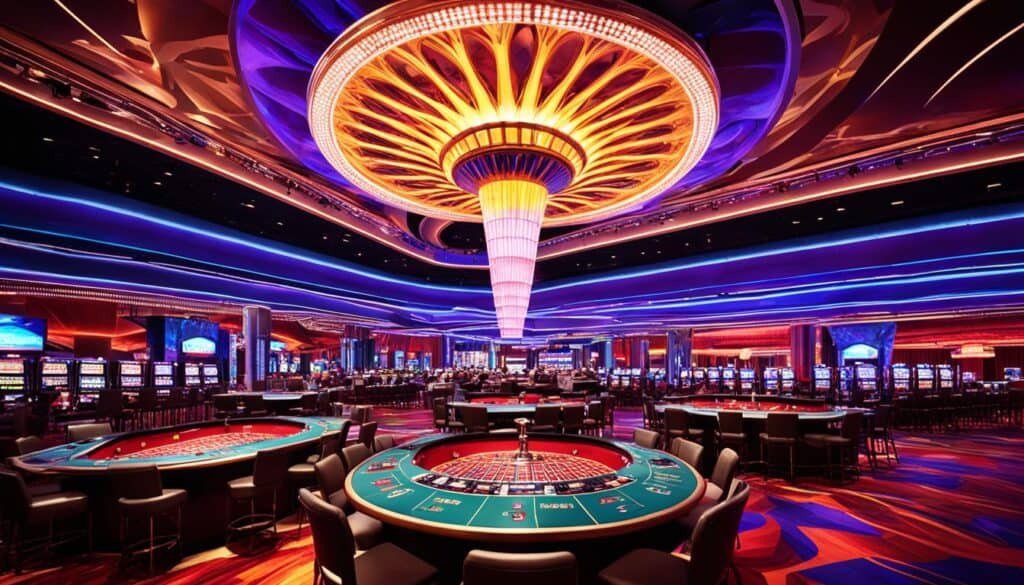
The integration of audio elements in gaming is a sophisticated art that shapes the soul-stirring environments within casinos across the globe. An exquisite blend of harmonies, tempos, and melodies come together to define a casino’s rhythmic tone, contributing significantly to the vibrant atmosphere that captivates gamblers. From the ringing of slot machines to the celebratory music after a winning round, sound effects play a tremendous role in enhancing the casino atmosphere, often acting as the unsung hero of gaming experiences.
- Captivating Rhythms: The tempo of the background music is engineered to keep adrenaline high. Uplifting beats encourage players to maintain their energy levels, thus stimulating continuous engagement with games.
- Auditory Signage: Strategic sound effects guide players through the casino floor, much like an audible map. The clink of coins and the shuffle of cards act as signposts, navigating players towards different gaming areas.
- Psychological Comfort: Familiar tunes and soundscapes are selected to create a sense of comfort and familiarity, a technique that encourages patrons to settle in and extend their play sessions.
- Atmospheric Harmony: Audio is tailored to complement the visual elements of the casino, creating a harmonious sensory experience that is both immersive and emotionally engaging.
- Perception of Luck: Certain sounds and melodies are deliberately composed to evoke feelings of success and luck, subtly influencing gambler’s emotions and their willingness to take risks.
It is clear that the casino’s rhythmic tone, shaped through audio elements, is not mere background noise. It is the pulse that drives the excitement of gambling, the thread that weaves together moments of anticipation and the soundtrack that celebrates every triumph within the casino walls. The careful orchestration of sound effects and music is a fundamental component in crafting an unforgettable casino atmosphere.
Visual Dynamics: How Video and Imagery Contribute to Casino Atmospheres
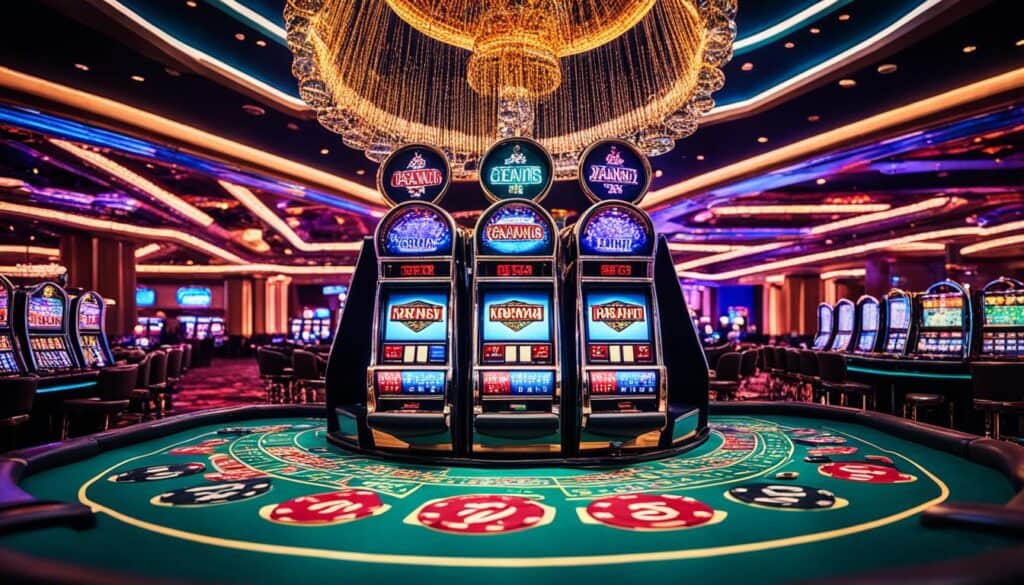
The continual evolution of casino atmospheres is significantly influenced by the incorporation of cutting-edge digital media. From the seamless integration of video dynamics to the awe-inspiring visual spectacles, the modern casino is transformed into an immersive domain of interactive storytelling and engagement. This deliberate use of video and dynamic imagery goes beyond mere decoration, playing a central role in shaping a player’s sensory experience and potentially influencing gambling behavior.
Integrating Digital Media with Casino Interiors
Integrating digital media within casino interiors isn’t a mere trend; it’s an essential part of crafting innovative and enticing gambling environments. Through the strategic use of digital displays, casinos can narrate their unique stories, showcase grandeur, and transmit important information, all while creating a visually dynamic atmosphere that aligns perfectly with the tempo of gaming excitement.
- Video walls that exhibit grand jackpots and welcome messages echo the magnitude of potential wins, heightening players’ anticipation.
- Interactive touch screens providing wayfinding and promotional content seamlessly merge utility with immersive entertainment.
- Slot machine displays with vivid animations and high-resolution graphics captivate players, making traditional reel-spinning a multi-sensory experience.
Creating Visual Spectacles to Complement Gambling Excitement
Visual spectacles act as the crescendo of casino atmospheres, augmenting the thrill of gambling with show-stopping aesthetics. High-definition screens and projectors display stunning visuals that dance to the beats of ambient audio, creating a celebration of wins that reverberates through the gaming floor. The fusion of stimulating content and artistic expression makes every moment spent within the casino’s realm feel like an inescapable dazzling production.
- Dazzling jackpot animations that envelope the player in a cocoon of celebratory visuals upon a win.
- Themed video displays that change to reflect events, seasons, or holidays, enriching the casino’s narrative and keeping the environment freshly engaging.
- Dynamic light shows synced with gaming actions, intensifying the emotional highs of casino gaming.
Redefining Space: Comfort and Enticement in Casino Environments
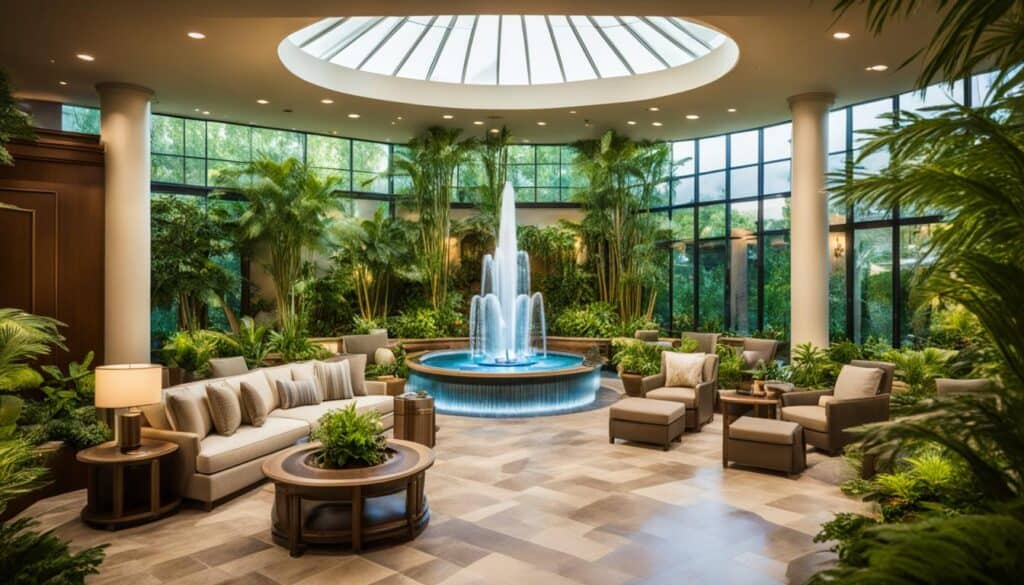
Modern casinos recognize the power of space in shaping a player’s experience and the fundamental role it plays in the psychology of gaming. By artfully designing spaces that blend comfort with strategic enticement, these establishments encourage patrons to immerse themselves in the captivating world of gambling. This sophisticated form of environmental psychology not only enhances the overall guest experience but becomes a powerful tool for increasing casino revenue.
The emphasis on comfort in casino design is more than just aesthetics—it’s about understanding the psychological triggers that coax players into longer and more frequent periods of engagement. Strategic manipulation of the environment brings a nuanced level of psychological enticement that is subtle but impactful in gaming environments.
The Psychological Pull of Contemporary Decor
Contemporary decor within a casino is not merely a backdrop—it’s an interactive feature that communicates luxury, excitement, and possibilities. Through the use of attractive visuals and tactile materials, customers find themselves engaged on a sensory level, which can trigger a more carefree and open-minded disposition towards gaming.
Inviting Layouts That Encourage Longer Stays
The layout of a casino floor can make or break the player’s journey. By employing inviting layouts that are intuitively navigable, a casino imparts a welcoming atmosphere, reducing frustration and fatigue. This approach to spatial design allows patrons to wander with ease, drawn naturally towards gaming areas, heightening curiosity and participation.
- Well-placed signage leading to key attractions
- Gaming tables and slot machines strategically arranged to promote exploration
- Rest and relaxation zones positioned to offer respite without leaving the premises
Psychological Effects of Casino Ambiance on Gamblers
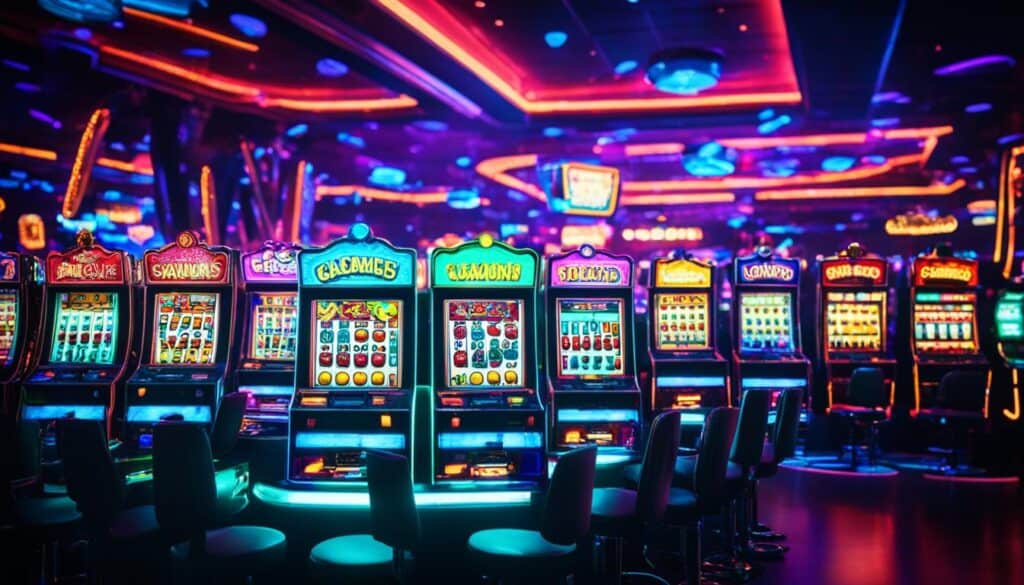
Delving into the realm of gambling psychology, it’s evident that the ambiance of a casino is a powerful tool in shaping player experiences and behaviors. From the intricate lighting designs to the rhythmic soundscape, every aspect of a casino is meticulously engineered to foster an environment conducive to gambling. The effects of ambiance on gambling are not just superficial; they reach deep into the psyche of players, affecting their emotional and mental states in profound ways.
Stress Reduction and Mental Restoration
One of the key goals for casino environments is to offer a form of escapism – a retreat from day-to-day routines. Casinos that succeed in reducing stress can facilitate a sense of mental restoration, allowing players to be more fully immersed in the experience. As they step onto the gaming floor, a transformation occurs, one where the weight of the outside world lifts and the anticipation of thrill takes over. In this sanctuary, players find joy in the play itself, often forgetting the pursuit of monetary gain.
Designing for Eudaimonic Experiences in Casinos
The concept of eudaimonia, which refers to a state of being where individuals experience a sense of fulfillment and well-being, is increasingly relevant in the design of modern casinos. By crafting spaces that promote these eudaimonic experiences, casinos can inspire positive feelings and connections to the act of gambling, far beyond the immediate highs of victory or the lows of defeat. It is the eudaimonic touch that can turn a casual visitor into a loyal patron, drawn back time and time again not solely by the prospect of winning, but by the holistic experience the environment provides.
Risk and Reward: How Casino Architecture Influences Betting Behaviors
The sophisticated blueprint of casino architecture is not merely a backdrop for the games it houses, but a calculated strategy to shape betting behaviors. Every arch, every light fixture, and the composition of the floor layout are components contributing to a canvas of risk-taking incentives. As players navigate through the space, they are enveloped in an environment crafted to elevate the sensation of risk with the allure of potential rewards. The design principles exceed functionality; they embody an unspoken language that communicates with the subconscious of the gambler, seamlessly blending comfort with the thrill of uncertainty.
In the liaison between form and function, casino designers employ a myriad of tactics to promote longer play and increased wager sizes. A sense of luxury and exclusivity, key features of effective casino architecture, works to assure patrons of the value in their spending, subtly endorsing bolder betting behaviors. Within these grand spaces, the line between reality and the engineered fantasies skews, and risk is perceived as part of an extraordinary experience rather than a mere financial transaction. In this domain, ceilings tower high, and the lights dance, orchestrating an atmosphere where every decision feels like a step towards an epic win.
The deliberate orchestration of sensory stimuli in casinos is a testament to understanding the psychology behind gaming enthusiasm. The sounds of success, the lush patterns on the carpet, and the strategic lighting all play a role in minimizing risk aversion, creating an undercurrent of daringness in the player’s mind. Fostering this realm where sensibilities are charmed into audacity is no accident. It is a well-studied application of environmental psychology aimed at amplifying risk-taking incentives. Casinos are not just gaming venues; they are theaters of possibility, architecturally perfected to cast the gambler not merely as a player but as a protagonist in a saga of risk and reward.
 Online Gaming Circuit
Online Gaming Circuit
